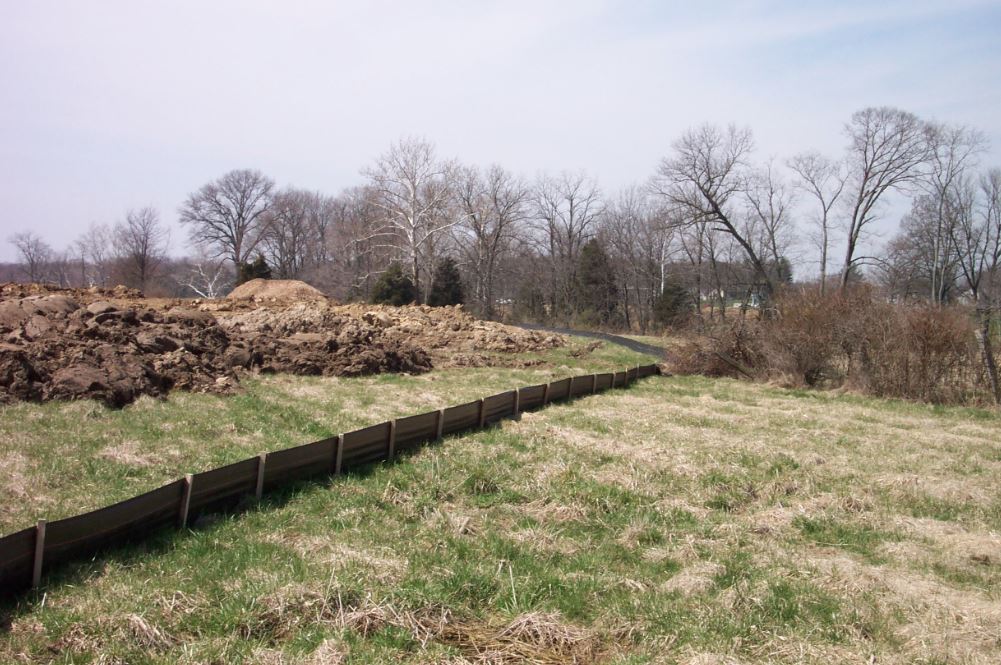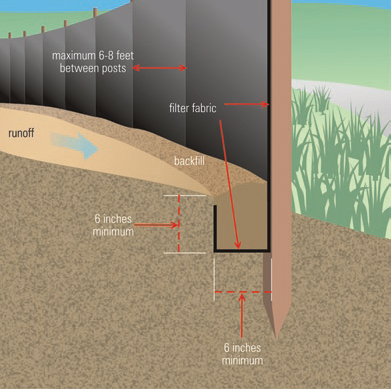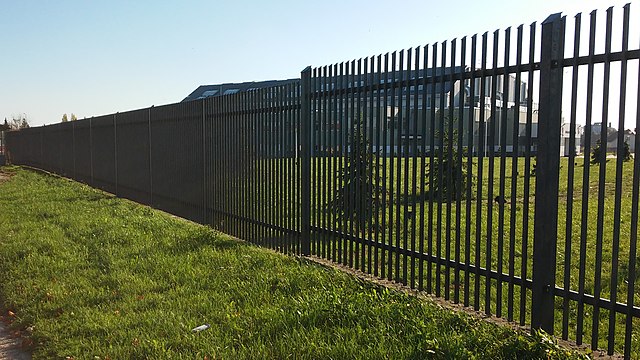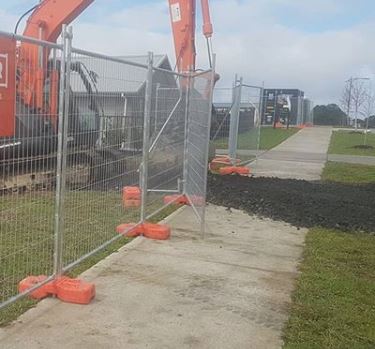Silt fences are an important component in stormwater management. By controlling the flow of water, they can help reduce the amount of runoff that enters our waterways. In this article, we will explore how silt fences work and how they can be used to manage stormwater runoff.
What Is A Silt Fence?
A silt fence is a temporary sediment control device that is typically made from a variety of materials including permeable fabric, plastic, wire mesh and wood. Silt fences are placed around construction sites where there is soil disturbance to capture sediment runoff before it enters a waterway and prevents erosion on the site.

How Do Temporary Silt Fences Work?
Silt fences work by using the force of gravity to slow down the flow of runoff. As the water flows through the fence, it slows down due to the increased surface area of the material. The water is suspended against the material of the fence and this allows sediment particles to settle out of the water so they can be collected or filtered out before entering downstream bodies or waterways. This often helps protect water quality.
Why Use Silt Fence?
Silt fences, also known as filter fence is an effective and affordable way to reduce the amount of sediment entering a waterway. They are easy to install, require little maintenance, and can last for the duration of the construction project and soil disturbance. Additionally, silt fences can help protect downstream areas from flooding or erosion caused by excess runoff.
Are Silt Fences Permanent?
No, silt fences are not permanent solutions. They are designed to be temporary sediment control fence and must be inspected regularly to ensure that they are still functioning properly. Additionally, they should be removed once construction is complete in order to reduce potential environmental impacts.

Where Should A Silt Fence Be Placed?
Silt fences should be placed at least 10 feet away from the edge of a construction site, and should always be sloped downward towards the outlet. Additionally, they should not be placed in areas with high water flow or steep slopes as these can damage the fence.
Erosion Control Tools Used With Silt Fences.
In order to ensure that silt fences are effective, it is important to use other erosion control tools in combination with them. These can include wattles, sediment basins, erosion control blankets and turf reinforcement matting. By using these additional tools in conjunction with silt fences, the effectiveness of sediment control can be greatly improved.
Wattle
A wattle is a temporary sediment control device that can be used in combination with silt fences. It is typically made from or includes natural materials such as straw, hay, coconut fiber or wood chips. Wattles are placed between the silt fence and the construction site to act as a filter and trap suspended solids out of the runoff before it enters downstream bodies of water.
Sediment Basin
A sediment basin is a temporary or permanent sediment control structure that is used to capture and contain sediment-laden runoff from construction sites. These basins are typically lined with an impermeable material such as plastic or rubber, and can be equipped with filtration systems or other measures to ensure that the discharged water meets state water quality standards.
Erosion Control Blanket
An erosion control blanket (ECB) is a synthetic fabric designed specifically to reduce the amount of soil erosion on slopes. ECBs are placed over exposed soil areas, such as those found at construction sites, and help hold the soil in place while allowing vegetation to take root. This helps stabilize the surface and reduce future erosion problems.
Turf Reinforcement Matting
Turf reinforcement matting (TRM) is a biodegradable, mesh-like material used to protect soil surfaces from erosion. TRM works by helping vegetation take root and strengthening the bond between the soil and roots. This helps to create a stronger surface layer that can better withstand wind and water erosion.
Who Installs Silt Fences?
A construction site work contractor who specializes in soil stabilization, erosion control and sediment is who to call when you need silt fence installation. Eastcoast Site Work provides silt fence sales and installation services for New Jersey and Eastern Pennsylvania. Call 732-370-0291 or contact us online to discuss your project.
Final Thoughts About Silt Fences For Stormwater Management
Eastcoast Sitework, is your premier provider of top-notch sediment control solutions and expert silt fence installation services. When it comes to stormwater management, silt fences play a crucial role in controlling water flow while safeguarding our environment and properties from potential damage.
Our high-quality silt fencing is designed to effectively keep sediment and other pollutants from entering local waterways. By choosing our silt fence, you are taking a proactive step towards protecting the natural ecosystem and ensuring water quality remains pristine.
One of the key benefits of silt fences is their ability to act as a temporary sediment barrier. This feature not only prevents sediment flow but also helps shield your property from potential harm caused by flooding or excessive runoff during heavy rainfalls or construction activities.
Does silt fence let water through? Absolutely! Our well-engineered silt fences strike the perfect balance between allowing water to pass through while effectively trapping and containing sediment. This ensures that stormwater can flow naturally without compromising the surrounding areas.
When it comes to silt fence installation, Eastcoast Sitework follows the proper protocols and best practices to ensure optimal performance. Our experienced team will meticulously install the silt fence to maximize its effectiveness in controlling sediment flow and promoting water quality.
At Eastcoast Sitework, we only use premium silt fence materials, including wire-backed silt fences, known for their exceptional durability and efficiency. These advanced materials provide added strength and stability to the silt fencing, ensuring reliable performance in challenging conditions.
Whether you need silt fences installed for construction projects, landscaping, or any other purpose, our team has the expertise to get the job done right. Our silt fence installation services are tailored to meet your specific needs and adhere to local regulations, guaranteeing a successful sediment control solution.
Don’t overlook the importance of sediment control fencing for both environmental conservation and property protection. Choose Eastcoast Sitework as your trusted partner for all your silt fencing needs and make a positive impact on stormwater management in our region. Contact us today to learn more about our services and how we can assist you in safeguarding our waterways and properties.
Need silt fence? Call 732-370-0291 or contact us Now
Frequently Asked Questions
Q: Which silt fence fabric should I purchase?
There are a few factors to consider when purchasing silt fence fabric. First, you need to decide what type of silt fence you need. There are three types of silt fences available: woven wire, welded wire, and plastic. Next, you need to determine the thickness of the fabric. Thicker fabrics are more durable and can withstand greater wear and tear. Finally, you need to decide on the length and width of the fabric. Be sure to choose a size that will be sufficient for your needs.
Q: Is it bad if sediments get into clean water?
The presence of sediments in water can often lead to a number of problems, including decreased water quality and clogged pipes and tubing. In addition, the presence of sediments can also lead to a decrease in the efficiency of water-treatment plants.
Additional Resources
- Do You Need a Portable Temporary Fence for Your Construction Site?
- What is Soil Stabilization in Road Construction
- How Is Straw Wattle Used For Erosion Control?
- Silt Fence Best Practices for Stormwater Management
- How does Vegetation Help Stabilize Slopes and Prevent Erosion?
- How Is Straw Wattle Used For Erosion Control?
- What is Soil Stabilization in Road Construction
- Types of Soil Erosion and Mitigation Strategies



